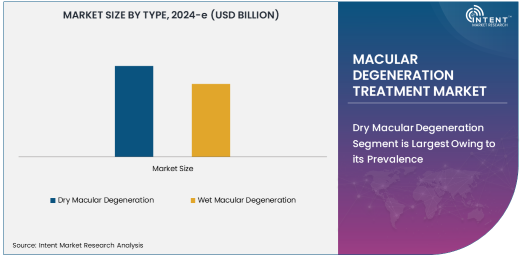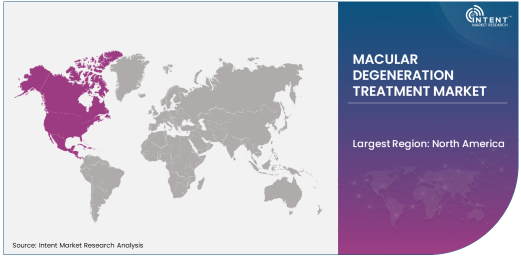As per Intent Market Research, the Macular Degeneration Treatment Market was valued at USD 4.3 Million in 2024-e and will surpass USD 9.2 Million by 2030; growing at a CAGR of 11.2% during 2025-2030.
The Macular Degeneration Treatment market focuses on managing and addressing vision loss caused by age-related macular degeneration (AMD). This progressive eye disease leads to the deterioration of the macula, impacting central vision. With increasing awareness and advancements in ophthalmic therapies, the demand for effective treatments such as Anti-VEGF therapies, corticosteroids, and photodynamic therapy has surged. Additionally, the growing geriatric population and the rising prevalence of AMD are contributing to the expansion of this market. Various end-user industries, including hospitals, ophthalmic clinics, and ambulatory surgery centers, are pivotal in providing these advanced treatments to patients.
Dry Macular Degeneration Segment is Largest Owing to its Prevalence
Dry macular degeneration (AMD) is the most common form of the condition, accounting for a significant portion of AMD cases globally. Unlike Wet AMD, which progresses rapidly, Dry AMD develops slowly and leads to gradual loss of vision over time. This subtype dominates the market due to its high prevalence among the aging population, along with limited treatment options focused on managing symptoms rather than halting progression entirely. As a result, the demand for effective monitoring and symptom management in hospitals and ophthalmic clinics remains strong, making Dry AMD a critical segment within the macular degeneration treatment market.

Anti-VEGF Therapy is Fastest Growing Due to High Efficacy
Among various treatment options, Anti-VEGF therapy has emerged as the fastest-growing segment in the macular degeneration treatment market. This therapeutic approach has demonstrated significant success in managing Wet AMD by reducing fluid leakage and slowing vision loss. The effectiveness of Anti-VEGF treatments is driving increasing adoption rates in hospitals and ophthalmic clinics, where patients seek more advanced and non-invasive solutions. Furthermore, ongoing research and development in this area continue to fuel its rapid growth, ensuring sustained market expansion.
End-User Industry Insights
Hospitals represent the largest segment in the macular degeneration treatment market, primarily due to their capability to provide comprehensive eye care services and advanced therapies under one roof. These institutions cater to a wide range of patients and have the necessary infrastructure for complex treatments like Photodynamic Therapy and Anti-VEGF injections. On the other hand, Ambulatory Surgery Centers (ASCs) are emerging as a fast-growing end-user segment, driven by their efficiency in offering outpatient procedures such as Anti-VEGF therapy, with reduced waiting times and lower costs for patients.
Largest Region: North America
North America stands as the largest region in the macular degeneration treatment market due to the high prevalence of AMD, robust healthcare infrastructure, and significant investments in ophthalmic research. The United States, in particular, has been at the forefront of advanced treatment options like Anti-VEGF and gene therapy. Additionally, favorable reimbursement policies for innovative treatments and a highly sophisticated healthcare system contribute to the dominance of this region.

Competitive Landscape
The macular degeneration treatment market is characterized by strong competition among key players such as Novartis, Regeneron Pharmaceuticals, Roche, and Bayer. These companies continuously invest in research and development, striving to introduce innovative therapies that offer improved patient outcomes. With the growing demand for advanced treatments, collaborations and partnerships are increasingly forming between pharmaceutical firms and biotech companies to explore novel solutions. As the landscape evolves, smaller players are also entering the market, driving further innovation and enhancing treatment availability.
Recent Developments:
- Novartis launched a new phase III trial for their innovative anti-VEGF therapy targeting Wet AMD in late 2024.
- Regeneron Pharmaceuticals announced FDA approval for its latest combination therapy for Wet AMD in early 2025.
- Roche expanded its portfolio with the release of a new photodynamic therapy product aimed at early-stage Dry AMD in mid-2024.
- Bayer acquired a stake in a biotechnology startup focused on gene therapy for macular degeneration in Q3 2024.
- Pfizer unveiled a new corticosteroid-based treatment for macular degeneration, showing promising results in clinical trials.
List of Leading Companies:
- Novartis
- Regeneron Pharmaceuticals
- Roche
- Bayer
- Pfizer
- Biogen
- Apellis Pharmaceuticals
- Apotex
- Allergan (AbbVie)
- Santen Pharmaceutical
- Genentech (a Roche Company)
- IVERIC bio
- Alimera Sciences
- Kala Pharmaceuticals
- Belite Bio
Report Scope:
|
Report Features |
Description |
|
Market Size (2024-e) |
USD 4.3 Million |
|
Forecasted Value (2030) |
USD 9.2 Million |
|
CAGR (2025 – 2030) |
11.2% |
|
Base Year for Estimation |
2024-e |
|
Historic Year |
2023 |
|
Forecast Period |
2025 – 2030 |
|
Report Coverage |
Market Forecast, Market Dynamics, Competitive Landscape, Recent Developments |
|
Segments Covered |
Macular Degeneration Treatment Market By Type (Dry Macular Degeneration, Wet Macular Degeneration), By Treatment (Anti-VEGF Therapy, Corticosteroids, Photodynamic Therapy), and By End-User Industry (Hospitals, Ophthalmic Clinics, Ambulatory Surgery Centers) |
|
Regional Analysis |
North America (US, Canada, Mexico), Europe (Germany, France, UK, Italy, Spain, and Rest of Europe), Asia-Pacific (China, Japan, South Korea, Australia, India, and Rest of Asia-Pacific), Latin America (Brazil, Argentina, and Rest of Latin America), Middle East & Africa (Saudi Arabia, UAE, Rest of Middle East & Africa) |
|
Major Companies |
Novartis, Regeneron Pharmaceuticals, Roche, Bayer, Pfizer, Biogen, Apellis Pharmaceuticals, Apotex, Allergan (AbbVie), Santen Pharmaceutical, Genentech (a Roche Company), IVERIC bio, Alimera Sciences, Kala Pharmaceuticals, Belite Bio |
|
Customization Scope |
Customization for segments, region/country-level will be provided. Moreover, additional customization can be done based on the requirements |
|
1. Introduction |
|
1.1. Market Definition |
|
1.2. Scope of the Study |
|
1.3. Research Assumptions |
|
1.4. Study Limitations |
|
2. Research Methodology |
|
2.1. Research Approach |
|
2.1.1. Top-Down Method |
|
2.1.2. Bottom-Up Method |
|
2.1.3. Factor Impact Analysis |
|
2.2. Insights & Data Collection Process |
|
2.2.1. Secondary Research |
|
2.2.2. Primary Research |
|
2.3. Data Mining Process |
|
2.3.1. Data Analysis |
|
2.3.2. Data Validation and Revalidation |
|
2.3.3. Data Triangulation |
|
3. Executive Summary |
|
3.1. Major Markets & Segments |
|
3.2. Highest Growing Regions and Respective Countries |
|
3.3. Impact of Growth Drivers & Inhibitors |
|
3.4. Regulatory Overview by Country |
|
4. Macular Degeneration Treatment Market, by Type (Market Size & Forecast: USD Million, 2023 – 2030) |
|
4.1. Dry Macular Degeneration |
|
4.2. Wet Macular Degeneration |
|
5. Macular Degeneration Treatment Market, by Treatment (Market Size & Forecast: USD Million, 2023 – 2030) |
|
5.1. Anti-VEGF Therapy |
|
5.2. Corticosteroids |
|
5.3. Photodynamic Therapy |
|
6. Macular Degeneration Treatment Market, by End-User Industry (Market Size & Forecast: USD Million, 2023 – 2030) |
|
6.1. Hospitals |
|
6.2. Ophthalmic Clinics |
|
6.3. Ambulatory Surgery Centers |
|
7. Regional Analysis (Market Size & Forecast: USD Million, 2023 – 2030) |
|
7.1. Regional Overview |
|
7.2. North America |
|
7.2.1. Regional Trends & Growth Drivers |
|
7.2.2. Barriers & Challenges |
|
7.2.3. Opportunities |
|
7.2.4. Factor Impact Analysis |
|
7.2.5. Technology Trends |
|
7.2.6. North America Macular Degeneration Treatment Market, by Type |
|
7.2.7. North America Macular Degeneration Treatment Market, by Treatment |
|
7.2.8. North America Macular Degeneration Treatment Market, by End-User Industry |
|
7.2.9. By Country |
|
7.2.9.1. US |
|
7.2.9.1.1. US Macular Degeneration Treatment Market, by Type |
|
7.2.9.1.2. US Macular Degeneration Treatment Market, by Treatment |
|
7.2.9.1.3. US Macular Degeneration Treatment Market, by End-User Industry |
|
7.2.9.2. Canada |
|
7.2.9.3. Mexico |
|
*Similar segmentation will be provided for each region and country |
|
7.3. Europe |
|
7.4. Asia-Pacific |
|
7.5. Latin America |
|
7.6. Middle East & Africa |
|
8. Competitive Landscape |
|
8.1. Overview of the Key Players |
|
8.2. Competitive Ecosystem |
|
8.2.1. Level of Fragmentation |
|
8.2.2. Market Consolidation |
|
8.2.3. Product Innovation |
|
8.3. Company Share Analysis |
|
8.4. Company Benchmarking Matrix |
|
8.4.1. Strategic Overview |
|
8.4.2. Product Innovations |
|
8.5. Start-up Ecosystem |
|
8.6. Strategic Competitive Insights/ Customer Imperatives |
|
8.7. ESG Matrix/ Sustainability Matrix |
|
8.8. Manufacturing Network |
|
8.8.1. Locations |
|
8.8.2. Supply Chain and Logistics |
|
8.8.3. Product Flexibility/Customization |
|
8.8.4. Digital Transformation and Connectivity |
|
8.8.5. Environmental and Regulatory Compliance |
|
8.9. Technology Readiness Level Matrix |
|
8.10. Technology Maturity Curve |
|
8.11. Buying Criteria |
|
9. Company Profiles |
|
9.1. Novartis |
|
9.1.1. Company Overview |
|
9.1.2. Company Financials |
|
9.1.3. Product/Service Portfolio |
|
9.1.4. Recent Developments |
|
9.1.5. IMR Analysis |
|
*Similar information will be provided for other companies |
|
9.2. Regeneron Pharmaceuticals |
|
9.3. Roche |
|
9.4. Bayer |
|
9.5. Pfizer |
|
9.6. Biogen |
|
9.7. Apellis Pharmaceuticals |
|
9.8. Apotex |
|
9.9. Allergan (AbbVie) |
|
9.10. Santen Pharmaceutical |
|
9.11. Genentech (a Roche Company) |
|
9.12. IVERIC bio |
|
9.13. Alimera Sciences |
|
9.14. Kala Pharmaceuticals |
|
9.15. Belite Bio |
|
10. Appendix |
A comprehensive market research approach was employed to gather and analyze data on the Macular Degeneration Treatment Market. In the process, the analysis was also done to analyze the parent market and relevant adjacencies to measure the impact of them on the Macular Degeneration Treatment Market. The research methodology encompassed both secondary and primary research techniques, ensuring the accuracy and credibility of the findings.
.jpg)
Secondary Research
Secondary research involved a thorough review of pertinent industry reports, journals, articles, and publications. Additionally, annual reports, press releases, and investor presentations of industry players were scrutinized to gain insights into their market positioning and strategies.
Primary Research
Primary research involved conducting in-depth interviews with industry experts, stakeholders, and market participants across the E-Waste Management ecosystem. The primary research objectives included:
- Validating findings and assumptions derived from secondary research
- Gathering qualitative and quantitative data on market trends, drivers, and challenges
- Understanding the demand-side dynamics, encompassing end-users, component manufacturers, facility providers, and service providers
- Assessing the supply-side landscape, including technological advancements and recent developments
Market Size Assessment
A combination of top-down and bottom-up approaches was utilized to analyze the overall size of the Macular Degeneration Treatment Market. These methods were also employed to assess the size of various subsegments within the market. The market size assessment methodology encompassed the following steps:
- Identification of key industry players and relevant revenues through extensive secondary research
- Determination of the industry's supply chain and market size, in terms of value, through primary and secondary research processes
- Calculation of percentage shares, splits, and breakdowns using secondary sources and verification through primary sources
.jpg)
Data Triangulation
To ensure the accuracy and reliability of the market size, data triangulation was implemented. This involved cross-referencing data from various sources, including demand and supply side factors, market trends, and expert opinions. Additionally, top-down and bottom-up approaches were employed to validate the market size assessment.
NA
